Do you want to prepare your car for winter so you can get where you want to go safely? Do you live in a part of the country with the potential for severe winter weather?
We’ll share some of the best and least expensive ideas for what to keep in your car and how to get your car ready for winter. That way you can go over the hills and through the woods, to whomever’s house you go.
If you winterize your car, despite harsh weather conditions, you’ll still keep yourself safe and you’ll be less likely to be stranded.
Winterizing Your Car Quick Summary:
To prepare your car for winter check that your tires and fluids are all in good condition. And be sure you have a tool kit, shovel, gear to keep you warm, and extra food and water all packed in your car.
Keep reading for our 15 Point Check List for Winter Driving.
The changing seasons affect us all. Winter can leave your vehicle susceptible to wear and tear if it’s not ready to take on the plummeting temperatures. However, there are plenty of tips and tricks you can follow to keep your car and its passengers both safe from harsh weather and out of harm’s way.
Use as many of these tips as possible to winterize your vehicle before the icy temperatures hit, and you can keep your car looking and functioning the best it can.
FREE .pdf CHECKLIST – Scroll to the bottom of the page to download our free 2-page checklist
15-Point Checklist to Prepare Your Car for Winter
1. Ensure Your Vehicle is Stable on Icy Roads
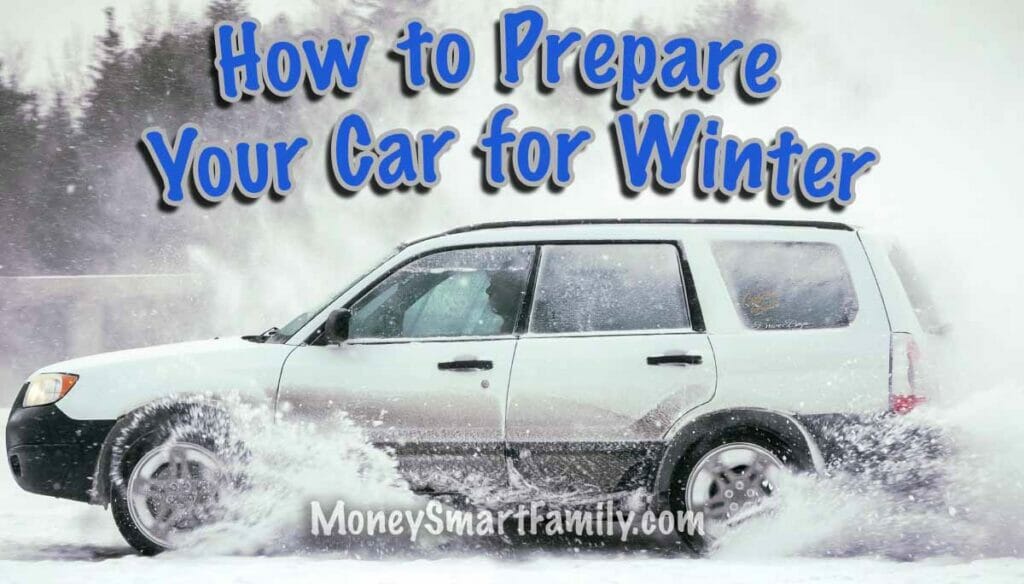
Whether you are a current car owner or are considering buying something else, there are a few things to know about what types of vehicles perform better on wintery roads.
RELATED ARTICLE: Used Car Buying Tips
When driving in conditions of snow or ice, it’s SUVs and cars with 4-wheel drive or all-wheel drive tend to be more stable. This article from KelleyBlueBook.com evaluates the best SUVs for driving in winter weather.
Kelley Blue Book has also published an article that reviews cars AND SUVs that do well in snowy conditions.
They believe that SUVs are better for winter safety for many reasons:
- Better overall weight distribution
- They’re also higher up, avoiding snow piles and packed-together ice spots
- Many offer 4-wheel drive
Regardless of what type of vehicle is on your driveway, it’s still important to prepare your car and winterize it so you can get the best possible performance.
Buying a newer car to prepare for winter driving is the most expensive option on this list.
Potential Cost: $7000 – $50,000
2. Get A Tune-Up
According to the National Highway Transportation Association, when considering how you could prepare your vehicle for winter, it’s important to make sure you’re getting regular tune-ups.
Tune-ups ensure that your car’s engine works properly and check that all combustion-related systems are functioning as they should. Getting a tune-up can even improve gas mileage for the coming season and will help you avoid problems that could be pricey to fix.
Potential Cost: $50 (DIY) – $400
3. Evaluate Your Tires
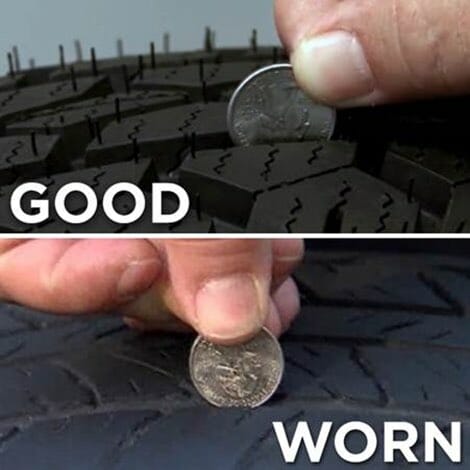
Checking your tire tread is especially important in the winter months to avoid the slipping and sliding that come with frozen-over roads.
According to the Colorado Department of Transportation, you can use the tried-and-true quarter method to measure tire tread and determine whether you should replace your tires, rotate them, or invest in sturdier alternatives for the upcoming season.
Also, be sure to check your tires’ air pressure frequently, as cold temperatures can cause deflation.
Typically, for every ten degrees (F), tire pressure will drop by one PSI. Fill your tires with air in the safety of your driveway before getting on the road and add air any time the TPMS light comes on.
Read this MoneySmartFamily article to find out where you can get your tires filled up for free
Potential Cost: $200 – $1000
Snow Tires:
Snow tires are pretty helpful when it comes to dangerous driving conditions. Not only do they help you prepare your car for winter by improving your traction and braking on the road, but they are also great when it comes to their rubber composition and precipitation-friendly trad design for icy roads.
Some of the main benefits of snow tires are:
1. Deeper Tread Depth:
Snow tires provide grip through surface snow and slush.
2. Groovy Tread Patterns:
Snow tire tread patterns have more grooves compared to all-season tires which help increase the surface area for traction.
Tire Chains as an Alternative to Snow Tires
Tire chains are another option you could look at during this winter. These chains are used in mountainous areas that have heavy or dense snow on the roads throughout the winter. How do they work you may ask, well it is quite simple. Traction and wheel spin are the two factors that play a role.
1. Traction
Tire chains wrap around the tread of the tires and hold on tightly to stop them from slipping. In other words, the chains give the tires the ability to have a better grip on snow and icy roads which allows the vehicle more traction and better control.
Something to keep in mind is to make sure you buy the correct size chains for your tires. If you do not use the correct size chains it may cause damage to your tires.
2. Wheel Spin
Tire chains also increase traction by preventing wheel spin. Wheel spins occur when the force delivered to the tire tread via the engine is greater than the tread-to-surface friction available, which causes the tires to lose traction.
Although tire chains are very helpful for driving through snow, you should remember not to drive faster than 30pmh when driving with tire chains. You should also not drive on bare asphalt with tire chains as it may result in a shorter lifespan for the chains.
Be sure to also check your spare tire.
4. Replace Antifreeze and Other Fluids
By making sure your car has an adequate amount of coolant at all times, you are minimizing the risk of freezing your engine, maintaining the cooling system, and avoiding long-term negative effects or breakdowns.
A few signs your car needs new antifreeze include fluid leaks underneath your vehicle, a sweet, maple-like odor, grinding noise, or a temperature gauge that reads very hot upon starting your car.
It’s also a good idea to replace other fluids, like oil, because it thickens in the cold and may not be as effective during the winter months.
Transmission fluid, brake fluid, and power steering fluid should also be checked to confirm they are at a safe level for proper use. Switch your washer-fluid for a solution that contains antifreeze to prevent it from freezing.
Potential Cost: $20 – $150 (should be included in your tune-up price)
5. Check Lights and Wipers
Less daylight means increased use of your car’s headlights and a greater need for reliable visibility during snowfall or heavy rain. Also, be sure to check blinkers, brakes, and fog lights frequently to avoid confusion while driving.
It’s also smart to inspect the condition of your windshield wiper blades and consider replacing them so you are equipped with high-quality wipers in the event of inclement weather. It is important to keep your windshield clear from falling snow, ice, or salt when driving around other cars. Obstruction of view can cause accidents and nervousness behind the wheel, so this is a crucial step to achieving vehicle safety in the winter.
Potential Cost: $25 – $75
6. Inspect Your Brakes
A brake malfunction is always bad, but winter weather can make matters even worse. Testing your car’s brakes and inspecting the brake pads to make sure they aren’t worn is a basic part of vehicle maintenance that can put your mind at ease when it’s time to head out on a snowy day.
When roads are wet and slippery, unresponsive brakes with worn rotators can cause pulling, grabbing, or slipping that may put you and other drivers in harm’s way.
Clues that your brakes may need servicing include squeaking or grinding when pressed, burning smell, leaking fluid, or vibrating. Try to address brake problems as promptly as possible, and ideally, before the snow starts to fall.
The cost for getting your brakes in tip-top shape will vary depending on your vehicle.
Potential Cost: $300 – $1000
7. Test your battery
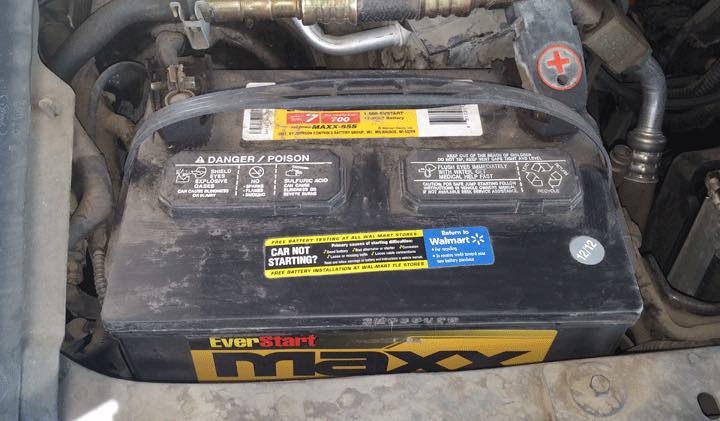
Cold temperatures can take a toll on a car’s battery and alternator, so it’s a good idea to run a few tests. Checking that battery cables and terminals have not corroded and are secure is a good place to start.
Many auto shops (O’Reilly, Pep Boys, Napa, Advance Auto Parts, and AutoZone) will test your battery to ease your concerns for no cost. Checking your battery before winter might save you the hassle of jump-starting your vehicle in the cold. If you’d prefer to look for yourself, a voltmeter reading of 12.4V or higher indicates that your battery is in good condition.
As the temperature drops, car engines use more power to start, so the battery works harder than usual to work properly. Keep your battery warm and insulated, or park in a garage if possible.
Keep an eye out for signs of a failing battery, such as a lag when you start the car, dim lights, or a clicking sound when starting the ignition.
Most auto parts stores will test your battery and can tell you if any cells are not performing perfectly.
Learn our favorite battery and one of the best car battery warranties out there – we’ve been buying these batteries since 2005.
The cost for a new battery will vary depending on your vehicle and the type of warranty that accompanies the battery.
Potential Cost: $100 – $300
8. Test Your Heating System
Spending long periods of time in the cold can be dangerous. If exposed to freezing temperatures for long enough, it can put you at risk for hypothermia. While driving, it is ideal to have a functioning heater inside of your car so you can warm up and be as safe, alert, and comfortable as possible. Be sure to check that the defroster is working, so on a frosty morning when the windows have iced over, you can simply melt it away without the hassle of scraping.
Replacing your cabin air filter(s) is a good way to keep your heating system performing well. Doing so can help avoid clogging, which greatly reduces airflow through the heater, and can put additional strain on your air conditioning compressor and your engine.
Also, note that most auto experts recommend allowing the engine to run for 30 seconds before driving off (read more about the proper way to warm up your car from MotorBiscuit.com).
Potential Cost – Cabin Air Filter: $30 (DIY) – $300
9. Keep Your Gas Tank Full
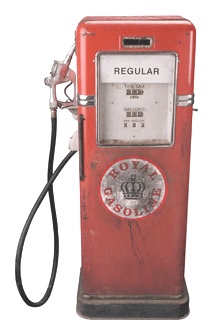
Moisture can build up in the empty space of a gas tank. That moisture can then dilute the fuel or even freeze, ruining parts of your car and needing immediate repair. By keeping your tank more than half full at all times, you can deter moisture from forming and protect your pump.
Get more details about winter and your gas tank in more detail from SouthernLiving.com.
that can occur in your gas tank and fuel lines in cold weather.
If you don’t plan to use your vehicle all winter or only plan to use it occasionally, it’s best to always keep the fuel tank completely full so that condensation never builds up.
Potential Cost: Gas at the Prevailing Price
10. Spray Down Window Tracks
Water can fall into window tracks and freeze, creating a scraping sensation when you try to open or close the windows.
Lubricate the tracks by soaking them to create a smooth glide and save your window regulator cables, which can be costly to replace.
This is a relatively easy tip that very few people consider and can save you time and money.
Potential Cost: Free
11. Lubricate Locks and Latches
Visit your local auto store, pick up a can of lubricant (silicone or dry Teflon), and spray down all the tiny spaces such as locks, latches, weather stripping, hinges, and doors that can become frozen and hard to open.
All United Locksmiths recommend the following lubricants to prevent locks from freezing:
- Hilco Lubricant
- WD-40 (but not too often as it wears out the tumblers)
- Vaseline – dip your key in the vaseline and then insert it into the lock once a week
- Graphite – another good lubricant to prevent locks from freezing
You may even consider spraying hood latches and the gas tank lid to keep these spaces easy to access. Silicone is a substance that stays slippery, even in extreme cold, and can therefore prevent surfaces from freezing over.
Simply open and shut the windows a few times to completely cover the tracks in lubricant, leaving them free to glide all winter long. As for the other surfaces, simply spraying them down will be enough to do the job.
Watch this video to learn how to unfreeze your car’s door locks
Potential Cost: $4 (DIY) – $100
12. Prepare and Protect the Inside of Your Car

There are plenty of technical reasons to prepare your car for winter, but you may also want to take action to preserve the look and aesthetic of your vehicle.
Consider purchasing weather mats to protect the carpeting inside your car from the salt and dirt your shoes may pick up. Before the icy weather hits, you might find it’s worth getting your car waxed, which serves as a protective coating that repels and protects against dirt and dust.
Check out these Deep Dish Floor mats for snowy conditions
You can also apply wax or spray to your tires to get rid of salt buildup. Invest in mud flaps to protect your fenders, wash off the salt from the road, and be sure to keep your distance from other cars while driving.
Tailgating can allow other cars to kick up debris onto your vehicle, damaging the exterior. When cleaning the exterior, use microfiber towels that will not scratch the paint.
Potential Cost: $40 – $100
13. Preparing Your Car for Winter in the Warmer States
If you live in a state that has a warmer climate than most, it’s easy to think you have nothing to worry about. Negligence to prepare for any scenario, however, can get you caught in a dangerous situation when winter strikes.
When subject to weather extremes of very high or very low changing temperatures, it is crucial to take good care of your vehicle’s battery and other systems by taking all the precautions listed above.
One of your first priorities should be to check your tire tread and make sure they can get you through icy patches safely and reliably.
Be proactive by storing warm weather gear in the trunk of your car, in a place that is accessible in case of exposure to extreme or constant cold. Winter preparation for your vehicle is just as pressing for “warm” states as it is everywhere else, and good planning can be the difference between a snowy drive and an emergency.
14. Check for Leaks with The Car Wash Trick
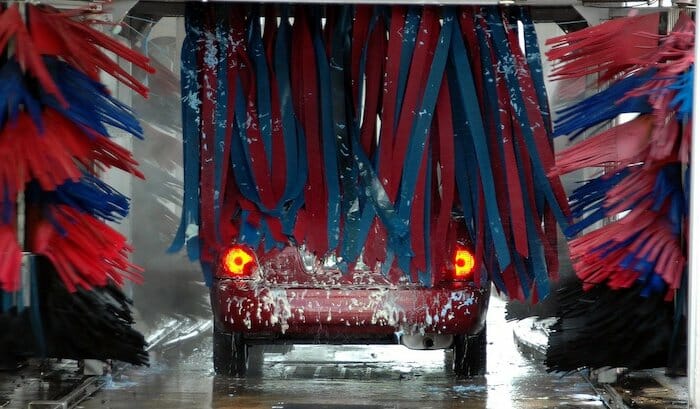
A car wash is a seasoned method of testing for interior leaks before winter. Drive through the car wash and watch for any water leaks in the interior of your car.
By locating a spot where water may enter the car, you can save yourself money in cleaning bills and the frustration of getting rid of the smell.
It is much harder to dry the interior of a leaky car during cold months, and mildew will likely grow in the carpets and fabric.
Use the car wash trick for good measure and to keep the inside of your car clean and dry. Common places for leaks to occur are through the sunroof, the edges of a convertible top, or faulty windows.
You may need to buy replacement gaskets or weather stripping. To save money, check eBay and Amazon for replacement parts before going to a dealer.
Potential Cost: Free (DIY) – $20
15. Prepare Your Winter Emergency Car Kit
Many people prepare their homes for storms by storing an emergency readiness kit indoors.
Similarly, it’s a good idea to keep a winter car emergency kit readily accessible in the trunk or the inside of your car. See the top-rated emergency car kits on Amazon.
The kit should contain essential items such as:
- First-aid kit
- Flashlights
- Batteries
- Radio
- Water
- Protein Bars and other non-perishable food
- Warm blankets – See Amazon’s Top Rated Mylar & Electric blankets for your car
- Gloves
- Jumper cables
- Ice scraper
- Matches
- Basic Auto toolkit – See the top-rated Auto Tool Kits between $50 and $80 here
- Paper towels
- Safety warning devices such as reflective triangles
- Portable phone charger (we like the Anker brand of chargers
- Kitty litter to help your tires gain traction if you get stuck on ice
- Water
- Flares – electronic or combustible
Potential Cost: $60 – $100

Saving Money by Preparing Your Car for Winter
It’s better to be safe than sorry, and these simple items can be lifesaving if you get stuck somewhere or are waiting for help.
It may cost you between $300 and $1000 the first time you get all of these preparations taken care of. But once you have all of the fundamentals prepared, your cost in future years will be much less.
Wintertime can pose many risks and challenges for drivers. Most of us can agree that transportation is an important part of our everyday lives, and preserving our vehicles should be a priority. By taking a few precautions and thinking ahead, you can prepare your vehicle for winter and for the worst while keeping yourself and your family safe.
Whether you live in (usually) warm Arizona or chilly Maine, winter safety should be an annual process for all car owners. By following this guide to preparing your vehicle for the winter months, you can preserve its aesthetic value and performance quality, saving you money and putting your mind at ease.
Vehicle maintenance is also a courtesy to those who share the road with you, as it prevents accidents and stops emergencies before they happen. Unlike these maintenance steps, the weather is something that you cannot control.
However, with the right planning, preparedness, and proactive responsibility, you can control your reaction to anything that comes your way, keeping even potentially dangerous situations under control.
And the real savings could be in keeping you out of an accident or warm and safe if your car is disabled.
Hope you have a safe and happy winter this year.
Fill in the info below to get a free copy of our preparing your car for winter checklist.
[birdsend form=12471]

